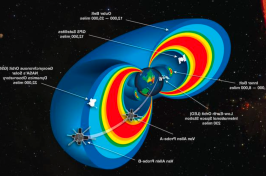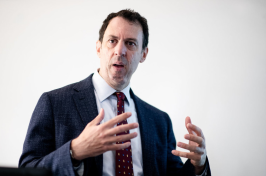
Tegan Lajoie ’26 and Abigail Randall work together to recreate an ancient Roman building using SketchUp software.
Walking through Pompeii as part of a study abroad opportunity, one of the ancient Roman buildings looked decidedly more familiar to Tegan Lajoie ’26 than the others.
She had not only previously stepped foot, virtually, inside the space during an art history course at UNH, but she had helped create the simulated reality design of the historic site that she and her classmates were digitally transported to.
Using the digital modeling software SketchUp, UNH art history students were able to precisely create detailed 3D models of ancient Roman buildings. And thanks in large part to donor funds that made the purchase of 16 virtual reality headsets possible, the students were also able to experience the virtual environments together, bringing a distinctly modern touch to historic coursework.
“The information we gathered from this course was better than any lecture or assignment we could’ve had,” Lajoie says. “Through the hands-on nature of the program, the information I studied became a vital area of interest to me, even after the class ended.”

Those teaching the classes utilizing technology felt similarly. For Ivo Van der Graaff, associate professor of art and art history, the program gave students an opportunity to engage with the course material in a way that more effectively brings the subject to life.
“Traditionally when it comes to art history, a lot of it is lecture-based, with an instructor trying to explain what a building looked like or what an object looked like. In this case the students were able to really understand not only the fundamentals of Roman architecture but really comprehend how Romans shaped and used these spaces in a very different way,” Van der Graaff says.
“It’s active learning at its best,” says Otto Luna, the digital resources curator in art and art history who was largely responsible for teaching the students how to use the technology. “They had to find the floor plans, they had to find sources to figure out what these buildings would have looked like in antiquity – it’s definitely a different way of getting the students to engage with the content, and a really interactive way for them to do that.”
For the project, students were tasked with researching and accurately recreating ancient Roman structures. Working in teams of two, they had to find floor plans, elevation plans and photographs of what was left of the buildings, Luna says, and then try to recreate them as they looked in antiquity, including authentic decorations, colors and other intricate details.
The measurements needed to be accurate, so that when viewed in virtual reality, everything appeared at scale. Utilizing the 16 headsets, the students and Van der Graaff – who led the lecture portion of the class – were able to enter the spaces in virtual reality at the same time and move around independently of each other. That allowed Van der Graaff to give the students tours, or for the students to give tours of their own reconstructions.
“We could use the models in a virtual environment to meet as a class and walk through the recreated buildings on a one-to-one scale,” Van der Graaff says. “And then we can have all sorts of conversations about lines of sight, construction, where certain decorations are in relation to others – you can really get immersive in that environment.”
The headsets necessary to allow the students to share in the 3D experience are expensive and would likely have been difficult to purchase without the support of donors. Those gift funds also helped bring to fruition the purchase of 10 high-end computers that allowed the students to do their modeling.
The technology has been a valuable tool in other courses throughout the art and art history department, as well, including studio art and a sculpture class that has used it to create virtual exhibits.
“It’s fantastic that there are people out there willing to give to things like this. We really appreciate the faith they have in our ideas and what we’re trying to push forward,” Van der Graaff says of the donors. “Very few programs across the United States are able to implement something like this, we’re at the cutting edge of this kind of learning. And on the student side, they come away with skills that can be used in the real world, regardless of area of study, because they understand these emerging technologies really well.”
Adds Luna: “This technology is really exciting. Ivo and I and others at the university really think hard before integrating it into our classes – we don’t just want it to be something that is fun and cool and new, but to really be valuable in teaching the content. With the added advantage that they are learning in-demand technology and digital skills that are going to be useful for them as they launch their careers.”
Students share the enthusiasm for the technology and for the impact the project had on them. Lajoie says she has worked with architecture and design programs before, but SketchUp really allowed her to “see my creations come to life.” The research aspects drove the material home, and in Lajoie’s case the experience was the primary driver of her seeking out a study abroad opportunity to move from virtual reality to real life.
“This class and project gave me an opportunity for an entirely new and different area of study, truly a whole new world for me,” Lajoie says. “Because of the lasting impact the class had for me, I signed up to go abroad and I even got the opportunity to see the structure I had recreated in person.”
Want to support art and art history, the College of Liberal Arts or any other area of UNH that means the most to you? Visit our giving page to explore all of your options to make a gift.
-
Written By:
Keith Testa | UNH Marketing | keith.testa@agmjbl.com

















































